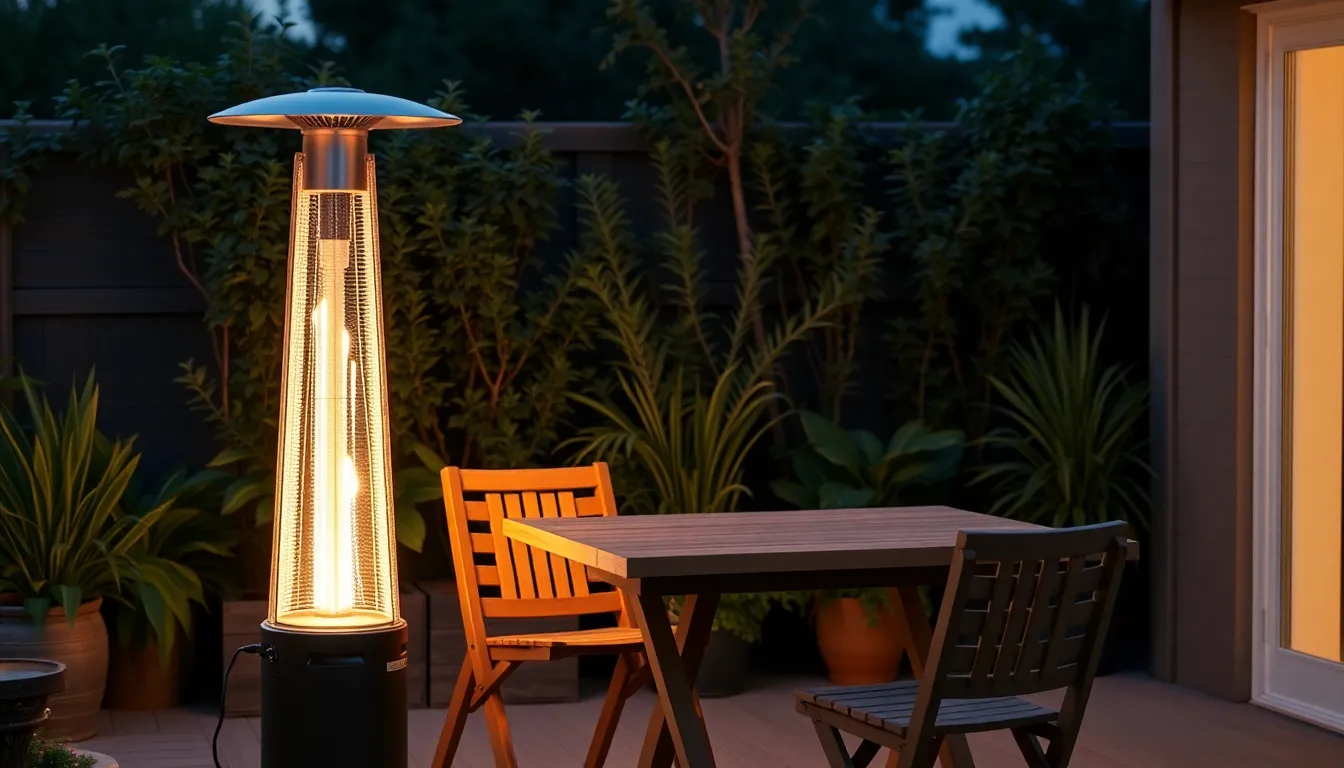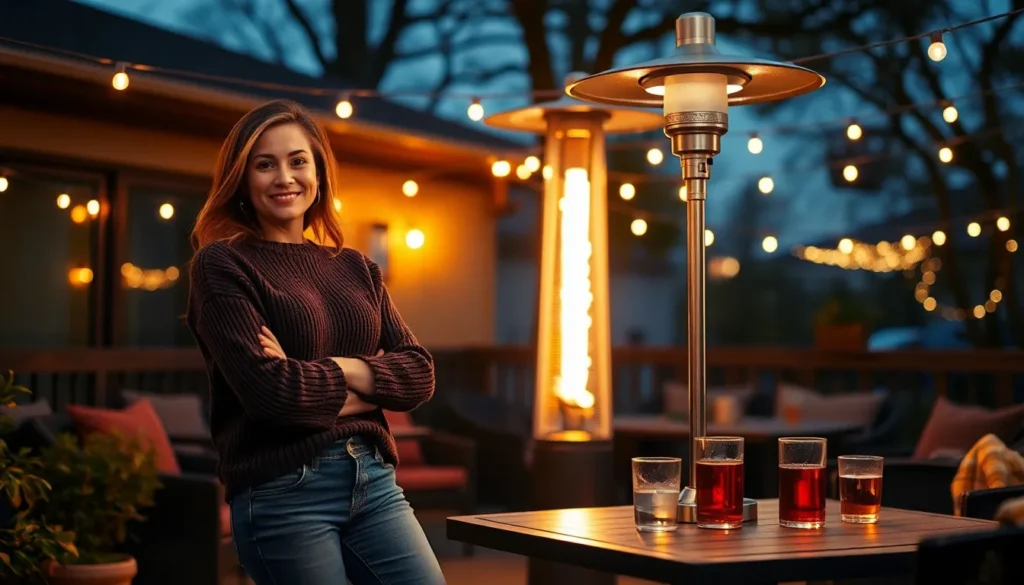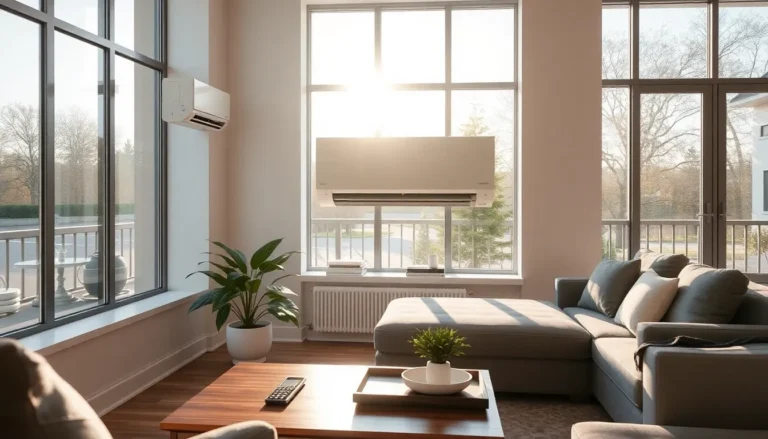Table of Contents
ToggleAs the sun dips below the horizon and the evening chill creeps in, outdoor gatherings can quickly turn into a frosty affair. Enter the patio heater, the unsung hero of backyard soirées. It’s like a warm hug for your outdoor space, ensuring that laughter and good times linger long after the sun has set.
What Is a Patio Heater?
A patio heater is a device designed to provide warmth in outdoor settings. These heaters extend the usability of outdoor spaces, making them comfortable during cooler weather. Various types exist, including propane, natural gas, and electric models.
The most common patio heater type is the propane heater, which operates using portable propane tanks. This model offers the advantage of mobility, allowing users to reposition the heater as needed. Natural gas patio heaters connect directly to a gas line, providing a continuous fuel source, which eliminates the need for tank replacement.
Electric patio heaters utilize electricity to generate heat, making them ideal for areas without gas connections. These heaters often feature adjustable settings, allowing users to select their preferred heat output.
Heaters come in various styles, with freestanding and tabletop options available. Freestanding models often reach heights of 7 to 8 feet, providing radiant heat coverage over a larger area. Tabletop units generally offer a more compact solution, suitable for smaller gatherings.
In terms of safety, patio heaters include features such as automatic shut-off valves, ensuring they turn off if tipped over. When selecting a unit, consider factors like heat output, fuel type, and design to match the outdoor space’s aesthetics.
Maintenance plays a crucial role in the longevity of patio heaters. Regular inspections for gas leaks, as well as cleaning surfaces and components, enhance performance. Choosing a high-quality model ensures efficient heating and durability, making outdoor experiences enjoyable year-round.
Types of Patio Heaters

Several types of patio heaters exist, each providing unique benefits for outdoor spaces. These heaters vary by fuel source and design, catering to different user preferences and settings.
Gas Patio Heaters
Gas patio heaters typically utilize natural gas or propane for fuel. Designed for sustained warmth, gas models supply consistent heat, making them perfect for larger areas. A connection to a gas line is often required for natural gas heaters, providing an endless fuel supply. Mobility is a plus for propane heaters, as portable tanks allow users to move them easily. Users appreciate gas heaters for their efficiency and quick heat-up times.
Electric Patio Heaters
Electric patio heaters rely on electricity to generate heat, making them convenient for locations without gas connections. Often featuring adjustable settings, these heaters allow individuals to control the desired heat output to suit specific needs. Regular maintenance is minimal, and installation usually involves simple plug-ins. Electric heaters are often safer in enclosed spaces, as they do not emit harmful gases. Environmentally conscious users prefer them due to lower carbon footprints compared to gas alternatives.
Propane Patio Heaters
Propane patio heaters are noted for their portability and versatility. Users can easily transport them to different locations, ensuring warmth wherever needed. These heaters typically operate with 20-pound propane tanks, allowing for considerable heating time without needing frequent refills. Many portable models come equipped with safety features, such as automatic shut-off, ensuring safe operation. Design options range from sleek and modern to traditional, matching various outdoor aesthetics.
Benefits of Using a Patio Heater
Patio heaters offer several advantages that enhance outdoor experiences, particularly in cooler weather.
Extended Outdoor Living Season
Extending the outdoor living season becomes achievable with patio heaters. These devices allow individuals to enjoy their patios even during fall or spring when temperatures drop. Transitioning from enjoying summer evenings to cozy gatherings becomes seamless. Properties with suitable outdoor settings benefit from patio heaters by providing warmth that encourages socialization. Outdoor spaces remain inviting, allowing for longer celebrations and gatherings. Enhanced usability for alfresco dining and entertaining leads to greater return on investment for home outdoor areas.
Improved Comfort
Improved comfort is a primary benefit of patio heaters. Guests enjoy warm surroundings while engaging in conversations or activities outside. Heat generated by these units creates a welcoming ambiance, helping individuals relax during evening get-togethers. Adjustable settings on electric models ensure that everyone can find their preferred level of warmth. The ability to host year-round events increases satisfaction. It allows for memorable nights spent under the stars without the discomfort of cold air, making patio heaters an essential addition to any outdoor space.
Key Features to Consider
Selecting the right patio heater involves evaluating several key features that enhance outdoor comfort and usability.
Heat Output
Heat output significantly affects a patio heater’s performance. This measurement is usually expressed in BTUs, which stands for British Thermal Units. A heater with higher BTUs provides more warmth, making it suitable for larger spaces. For example, 40,000 BTUs typically suffice for a medium-sized patio, while larger areas might need models offering 50,000 BTUs or more. Additionally, some heaters include adjustable settings, allowing users to customize heat levels based on their needs and preferences.
Fuel Type
Choosing the appropriate fuel type impacts both functionality and convenience. Propane heaters work using portable tanks, making them easy to relocate. Users may prefer natural gas models for their consistent energy source, ideal in settings with gas lines. Electric heaters present another option, operating through standard electrical outlets. This type is commonly favored in enclosed spaces for its safety features and low carbon emissions. Each fuel type offers unique advantages, so considering the specific outdoor environment is essential.
Design and Portability
Design influences not just aesthetics but also functionality. Freestanding patio heaters reach heights of 7 to 8 feet, providing wide-ranging heat coverage. Tabletop options, designed for smaller gatherings, enhance intimacy and warmth. When it comes to portability, selecting lightweight heaters with wheeled bases makes moving them around effortless. Many models offer stylish finishes that complement different outdoor décor. Thus, form and function intertwine, helping users find the perfect heating solution for their outdoor space.
Maintenance and Safety Tips
Regular maintenance of patio heaters ensures optimal performance and longevity. Inspect the heater periodically for gas leaks, especially in gas models. Utilizing soapy water on connections highlights leaks through bubbling. Cleaning the heater after each use extends its lifespan; remove dirt and debris from burners and surfaces.
Safety during operation remains crucial. Keep propane tanks upright and store them in a well-ventilated area away from flammable materials. Avoid using patio heaters indoors or in enclosed spaces to prevent carbon monoxide exposure. When operating the heater, maintain a safe distance from flammable objects such as furniture, clothing, and foliage.
Proper usage aligns with manufacturer guidelines. Follow specific instructions for ignition, shutdown procedures, and fuel types to minimize risks. Employ an automatic shut-off feature for safety, especially in freestanding models. In windy conditions, consider positioning heaters in sheltered areas to prevent tipping.
Monitor the heater for unusual noises or smells. Identify any signs of malfunction early to ensure safe use. Ensure that all connections and hoses are intact and free from damage.
Utilizing high-quality, well-reviewed patio heaters adds a layer of safety and efficiency. Regularly check heating elements in electric models and ensure proper electrical connections. Store heaters away from adverse weather conditions when not in use.
Whether hosting gatherings or enjoying quiet evenings outside, adhering to maintenance and safety tips provides peace of mind. Focus on these practices to create a warm, inviting outdoor atmosphere without compromising safety.
Patio heaters are invaluable for enhancing outdoor experiences during cooler months. They not only provide warmth but also create an inviting atmosphere that encourages social gatherings. With various types available, including propane, natural gas, and electric models, there’s a perfect option for every outdoor space.
Prioritizing safety and maintenance ensures these heaters function effectively and last longer. By selecting the right model and following best practices, individuals can enjoy their patios year-round, making outdoor living a delightful reality. Embracing the comfort of a patio heater transforms chilly evenings into memorable moments spent with friends and family.







